An Improved NSGA-II Algorithm for Multi-Objective Optimization of Irregular Polygon Patch Antennas
Abstract
1. Introduction
2. Antenna Structure and Problem Description
2.1. Antenna Structure
2.2. Problem Description
- 1.
- Center of Gravity Constraint: The origin of the coordinate system must coincide with the polygon patch’s center of gravity to ensure that the generated polygon shape meets the requirements to avoid unnecessary deformation or overlap. This condition is expressed as:
- 2.
- Probe Distance Constraint: The distance f from the center of the feed probe to the origin must not exceed the average distance of the polygon vertices to the origin. This ensures that the feed probe remains within the bounds of the substrate and avoids physical interference:
- 3.
- Vertex Connectivity Constraint: The edges of the polygon must connect vertices in the order of increasing angular positions to avoid self-intersections and maintain a valid polygon structure.
- 4.
- Side Length Constraint: The largest side length of the polygon must be at least twice the average distance of its vertices from the origin to ensure the patch area fits within the dielectric substrate.
- 1.
- To maximize the bandwidth of the antenna within the frequency range of 8–12 GHz.
- 2.
- To minimize the physical volume of the antenna.
| Algorithm 1: Calculate bandwidth of antenna. |
|
3. Antenna Optimization
3.1. Principle of the Improved Nsga-II Algorithm
3.2. Antenna Representation and Data Structure
3.3. Initialization of the Antenna Population
3.4. Generation of New Individuals
3.4.1. Mutation Strategies for Generating Offspring
- 1.
- Selection of Vertex Index: Generate a random number from a uniform distribution . The index i of the vertex to mutate is then determined as follows:
- 2.
- Generation of New Vertex Coordinates: Generate new polar coordinates from uniform distributions and respectively:Convert polar coordinates to Cartesian coordinates :
- 3.
- Updating Vertex Coordinates: Replace the original coordinates with the new coordinates in the individual p.
- 4.
- Recalculation of Centroid and Re-sorting: Recalculate the centroid of the updated polygon and translate the vertices to align the centroid with the origin, followed by angular sorting to maintain a valid polygon structure.
- 5.
- Adjustment of and : If the new side length L is less than , it is regenerated from the uniform distribution . Similarly, if the new probe position f exceeds , it is regenerated from . These adjustments ensure that all design parameters remain within feasible limits.
3.4.2. Crossover Mechanisms for Generating Offspring
3.4.3. Selection Procedures in Evolutionary Process
4. Simulation and Measurement
4.1. Parameter Settings
4.2. Calculation Results
4.3. Antenna Design Performance Analysis
5. Conclusions
Author Contributions
Funding
Data Availability Statement
Conflicts of Interest
References
- Sundarsingh, E.F.; Velan, S.; Kanagasabai, M.; Sarma, A.K.; Raviteja, C.; Alsath, M.G.N. Polygon-Shaped Slotted Dual-Band Antenna for Wearable Applications. IEEE Antennas Wirel. Propag. Lett. 2014, 13, 611–614. [Google Scholar] [CrossRef]
- Saxena, P.; Kothari, A. Mathematical Modeling of n-Sided Polygon Metamaterial Split Ring Resonators for 5.8 GHz ISM Band Applications. Wirel. Pers. Commun. 2017, 96, 5959–5971. [Google Scholar] [CrossRef]
- Bose, S.; Ramaraj, M.; Raghavan, S.; Kumar, S. Mathematical Modeling, Equivalent Circuit Analysis and Genetic Algorithm Optimization of an N-sided Regular Polygon Split Ring Resonator (NRPSRR). Procedia Technol. 2012, 6, 763–770. [Google Scholar] [CrossRef]
- Sorokosz, L.; Zieniutycz, W. On the Approximation of the UWB Dipole Elliptical Arms with Stepped-Edge Polygon. IEEE Antennas Wirel. Propag. Lett. 2012, 11, 636–639. [Google Scholar] [CrossRef]
- Joshi, A.; Singhal, R. Gain improvement in polygonal patch antennas. In Proceedings of the 2015 Annual IEEE India Conference (INDICON), New Delhi, India, 17–20 December 2015; pp. 1–5. [Google Scholar] [CrossRef]
- Herscovici, N.; Osorio, M.; Peixeiro, C. Miniaturization of rectangular microstrip patches using genetic algorithms. IEEE Antennas Wirel. Propag. Lett. 2002, 1, 94–97. [Google Scholar] [CrossRef]
- Jayasinghe, J.W.; Anguera, J.; Uduwawala, D.N. A high-directivity microstrip patch antenna design by using genetic algorithm optimization. Prog. Electromagn. Res. C 2013, 37, 131–144. [Google Scholar] [CrossRef]
- Nguyen, T.H.; Morishita, H.; Koyanagi, Y.; Izui, K.; Nishiwaki, S. A Multi-Level Optimization Method Using PSO for the Optimal Design of an L-Shaped Folded Monopole Antenna Array. IEEE Trans. Antennas Propag. 2014, 62, 206–215. [Google Scholar] [CrossRef]
- Bianchi, D.; Genovesi, S.; Monorchio, A. Constrained Pareto Optimization of Wide Band and Steerable Concentric Ring Arrays. IEEE Trans. Antennas Propag. 2012, 60, 3195–3204. [Google Scholar] [CrossRef]
- Goudos, S.K.; Sahalos, J.N. Pareto Optimal Microwave Filter Design Using Multiobjective Differential Evolution. IEEE Trans. Antennas Propag. 2010, 58, 132–144. [Google Scholar] [CrossRef]
- Yuan, Y.; Chan, C.; Man, K.; Mittra, R. A genetic algorithm approach to FSS filter design. In Proceedings of the IEEE Antennas and Propagation Society International Symposium, 2001 Digest, Held in Conjunction with: USNC/URSI National Radio Science Meeting (Cat. No.01CH37229), Boston, MA, USA, 8–13 July 2001; Volume 4, pp. 688–691. [Google Scholar] [CrossRef]
- Venkatarayalu, N.; Ray, T.; Gan, Y.B. Multilayer dielectric filter design using a multiobjective evolutionary algorithm. IEEE Trans. Antennas Propag. 2005, 53, 3625–3632. [Google Scholar] [CrossRef]
- Singh, P.; Rossi, M.; Couckuyt, I.; Deschrijver, D.; Rogier, H.; Dhaene, T. Constrained multi-objective antenna design optimization using surrogates. Int. J. Numer. Model. Electron. Netw. Devices Fields 2017, 30, e2248. [Google Scholar] [CrossRef]
- Bhattacharya, S.; Chattopadhyay, S.; Talukder, S.; Bag, S.; Mishra, S.; Gangopadhyaya, M. Optimization of inset-fed microstrip patch antenna using genetic algorithm. In Proceedings of the 2015 International Conference and Workshop on Computing and Communication (IEMCON), Vancouver, BC, Canada, 15–17 October 2015; pp. 1–4. [Google Scholar] [CrossRef]
- Dierck, A.; Declercq, F.; Vervust, T.; Rogier, H. Design of a Circularly Polarized Galileo E6-Band Textile Antenna by Dedicated Multiobjective Constrained Pareto Optimization. Int. J. Antennas Propag. 2015, 2015, 895963. [Google Scholar] [CrossRef]
- Koziel, S.; Ogurtsov, S. Multi-Objective Design of Antennas Using Variable-Fidelity Simulations and Surrogate Models. IEEE Trans. Antennas Propag. 2013, 61, 5931–5939. [Google Scholar] [CrossRef]
- Liu, S.; Wang, Q.; Gao, R. A topology optimization method for design of small GPR antennas. Struct. Multidiscip. Optim. 2014, 50, 1165–1174. [Google Scholar] [CrossRef]
- Wang, Q.; Gao, R.; Liu, S. A novel parameterization method for the topology optimization of metallic antenna design. Acta Mech. Sin. 2017, 33, 1040–1050. [Google Scholar] [CrossRef]
- Dutta, S.; Das, K.N. A Survey on Pareto-Based EAs to Solve Multi-objective Optimization Problems. In Soft Computing for Problem Solving; Springer: Singapore, 2019; pp. 807–820. [Google Scholar]
- Falcón-Cardona, J.G.; Coello, C.A.C. Indicator-based Multi-objective Evolutionary Algorithms: A Comprehensive Survey. ACM Comput. Surv. 2020, 53, 29:1–29:35. [Google Scholar] [CrossRef]
- Trivedi, A.; Srinivasan, D.; Sanyal, K.; Ghosh, A. A Survey of Multiobjective Evolutionary Algorithms Based on Decomposition. IEEE Trans. Evol. Comput. 2017, 21, 440–462. [Google Scholar] [CrossRef]
- Shirajuddin, T.M.; Muhammad, N.S.; Abdullah, J. Optimization problems in water distribution systems using Non-dominated Sorting Genetic Algorithm II: An overview. Ain Shams Eng. J. 2023, 14, 101932. [Google Scholar] [CrossRef]
- Wang, X.; Zhu, H.; Luo, X.; Chang, S.; Guan, X. A novel optimal dispatch strategy for hybrid energy ship power system based on the NSGA-II. Electr. Power Syst. Res. 2024, 232, 110385. [Google Scholar] [CrossRef]
- Arani, M.S.; Shahidi, R.; Zhang, L. A State-of-the-Art Survey on Advanced Electromagnetic Design: A Machine-Learning Perspective. IEEE Open J. Antennas Propag. 2024, 5, 1077–1094. [Google Scholar] [CrossRef]
- Pietrenko-Dabrowska, A.; Koziel, S. Dimensionality-reduced antenna modeling with stochastically established constrained domain. Knowl. Based Syst. 2023, 271, 110557. [Google Scholar] [CrossRef]
- Xie, J.; Chen, S.; Cai, J.; Zhao, P.; Cheng, Y.; Liu, J.; Wang, G. A Wideband GaAs Double-balanced Mixer using Genetic Algorithm based Optimization. In Proceedings of the 2023 16th UK-Europe-China Workshop on Millimetre Waves and Terahertz Technologies (UCMMT), Guangzhou, China, 31 August–3 September 2023; Volume 1, pp. 1–3. [Google Scholar] [CrossRef]
- Cheng, Y.F.; Shao, W.; Ding, X.; Yu, M.; Ma, J.; Jin, C. A novel beam steerable antenna based on dual-reconfiguration technique. J. Electromagn. Waves Appl. 2017, 31, 740–751. [Google Scholar] [CrossRef]
- Li, Y.; Yang, S.; Ren, Z. A Multi-Objective Topology Optimization Methodology Using Deep Learning and Its Application to Electromagnetic Devices. IEEE Trans. Magn. 2024, 60, 8000305. [Google Scholar] [CrossRef]
- Huang, J.; Li, W.; He, Y.; Zhang, L.; Wong, S.W. Optimization of Antenna Design Using the Artificial Neural Network and the Simulated Annealing Algorithm. In Proceedings of the 2021 Computing, Communications and IoT Applications (ComComAp), Shenzhen, China, 26–28 November 2021; pp. 119–122. [Google Scholar] [CrossRef]
- He, Y.; Huang, J.; Li, W.; Zhang, L.; Wong, S.W.; Chen, Z.N. Hybrid Method of Artificial Neural Network and Simulated Annealing Algorithm for Optimizing Wideband Patch Antennas. IEEE Trans. Antennas Propag. 2024, 72, 944–949. [Google Scholar] [CrossRef]
- Mishra, B.; Verma, R.K.; Yashwanth, N.; Singh, R.K. A review on microstrip patch antenna parameters of different geometry and bandwidth enhancement techniques. Int. J. Microw. Wirel. Technol. 2022, 14, 652–673. [Google Scholar] [CrossRef]
- Alnahwi, F.M.; Al-Yasir, Y.I.A.; Ali, N.T.; Gharbia, I.; See, C.H.; Abd-Alhameed, R.A. A Compact Wideband Circularly Polarized Planar Monopole Antenna With Axial Ratio Bandwidth Entirely Encompassing the Antenna Bandwidth. IEEE Access 2022, 10, 81828–81835. [Google Scholar] [CrossRef]
- Mahendran, K.; Gayathri, D.; Sudarsan, H. Design of multi band triangular microstrip patch antenna with triangular split ring resonator for S band, C band and X band applications. Microprocess. Microsyst. 2021, 80, 103400. [Google Scholar] [CrossRef]
- Deb, K.; Pratap, A.; Agarwal, S.; Meyarivan, T. A fast and elitist multiobjective genetic algorithm: NSGA-II. IEEE Trans. Evol. Comput. TEC 2002, 6, 182–197. [Google Scholar] [CrossRef]
- Borazjani, O.; Naser-Moghadasi, M.; Rashed-Mohassel, J.; Sadeghzadeh, R.A. Bandwidth improvement of planar antennas using a single-layer metamaterial substrate for X-band application. Int. J. Microw. Wirel. Technol. 2020, 12, 906–914. [Google Scholar] [CrossRef]
- Kiruthika, R.; Shanmuganantham, T. Comparison of different shapes in microstrip patch antenna for X-band applications. In Proceedings of the 2016 International Conference on Emerging Technological Trends (ICETT), Kollam, India, 21–22 October 2016; pp. 1–6. [Google Scholar] [CrossRef]
- Islam, M.M.; Islam, M.T.; Faruque, M.R.I.; Hueyshin, W. Design of an X-band microstrip patch antenna with enhanced bandwidth. In Proceedings of the 2013 2nd International Conference on Advances in Electrical Engineering (ICAEE), Dkaka, Bangladesh, 19–21 December 2013; pp. 313–317. [Google Scholar] [CrossRef]
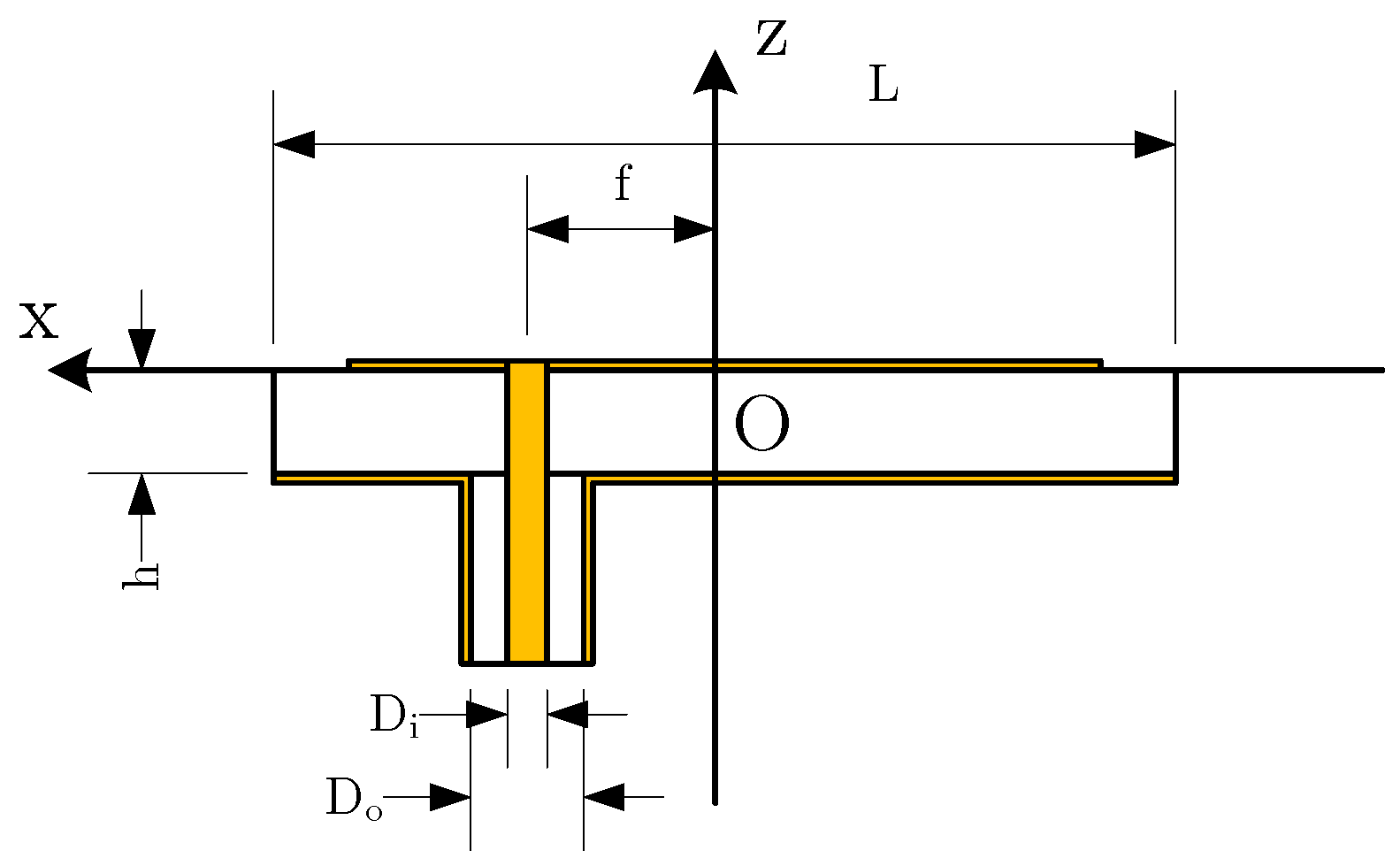
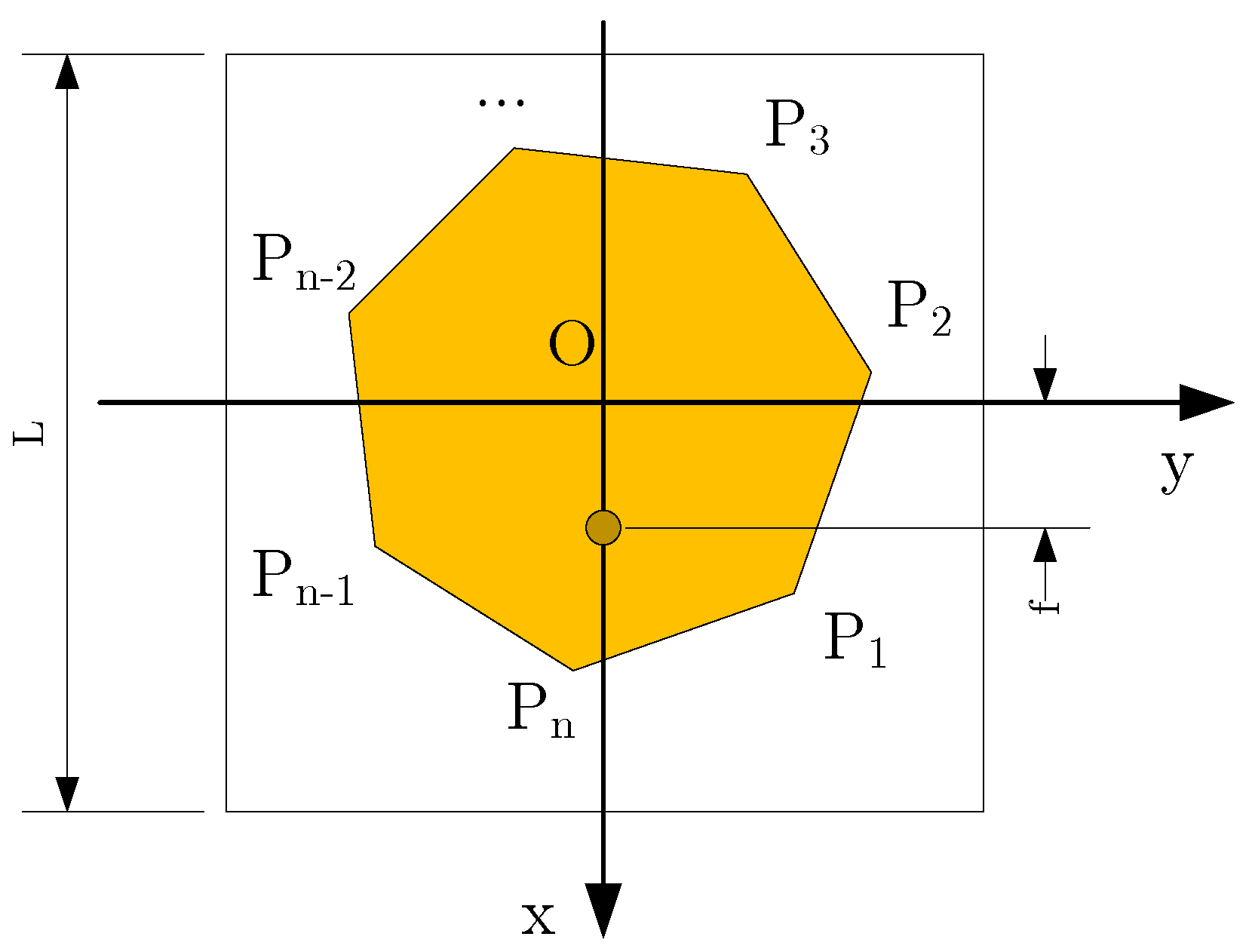



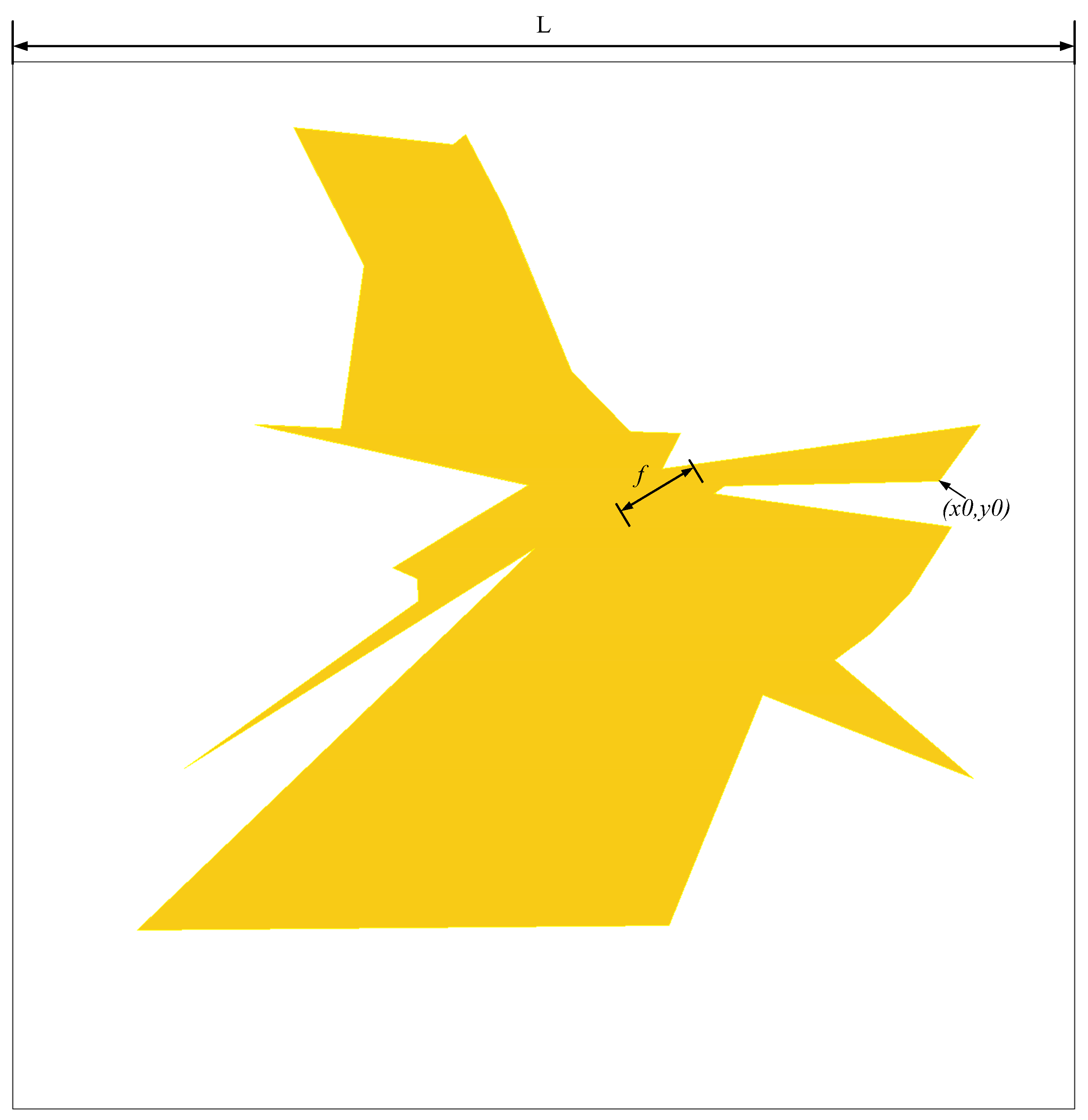
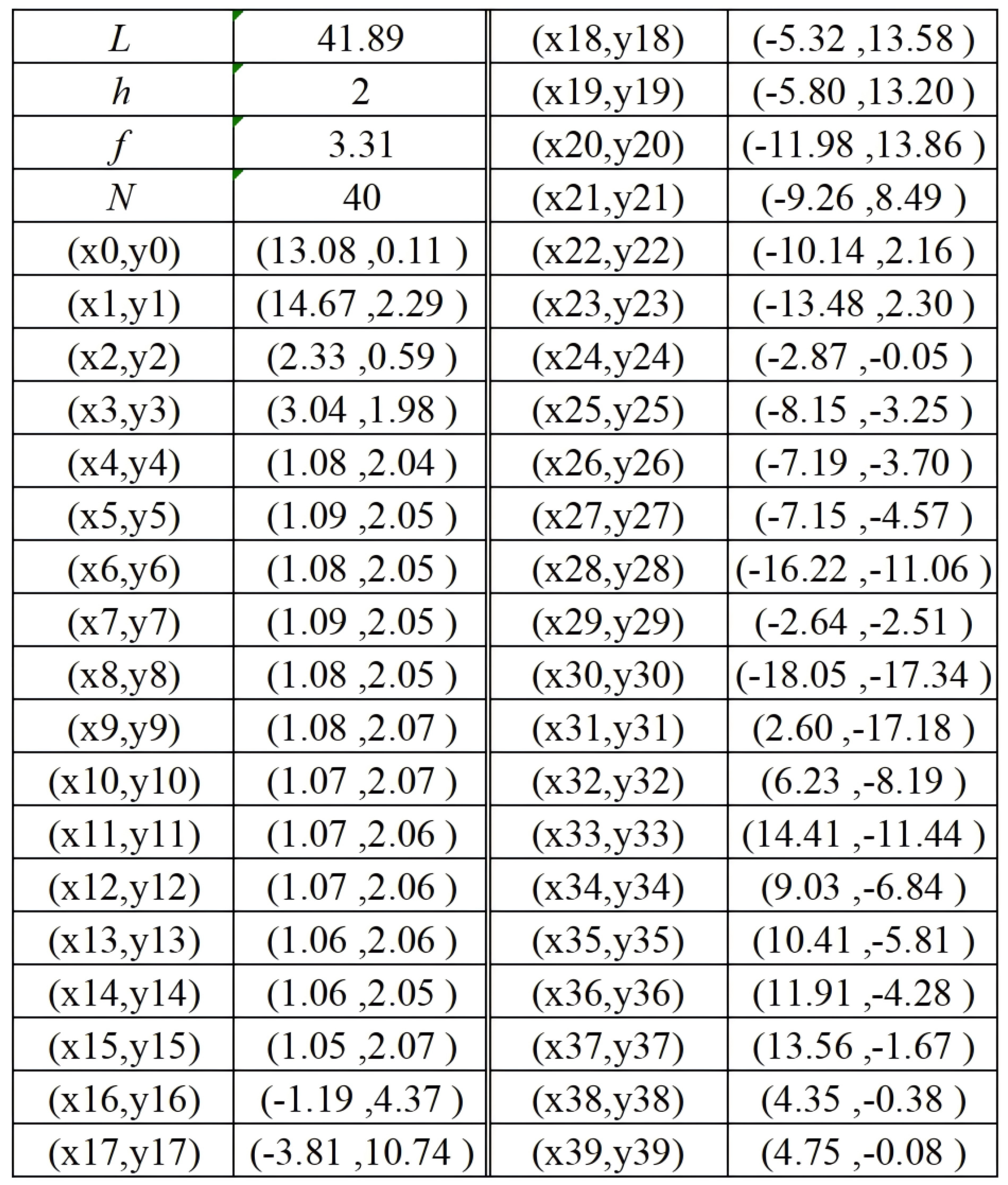


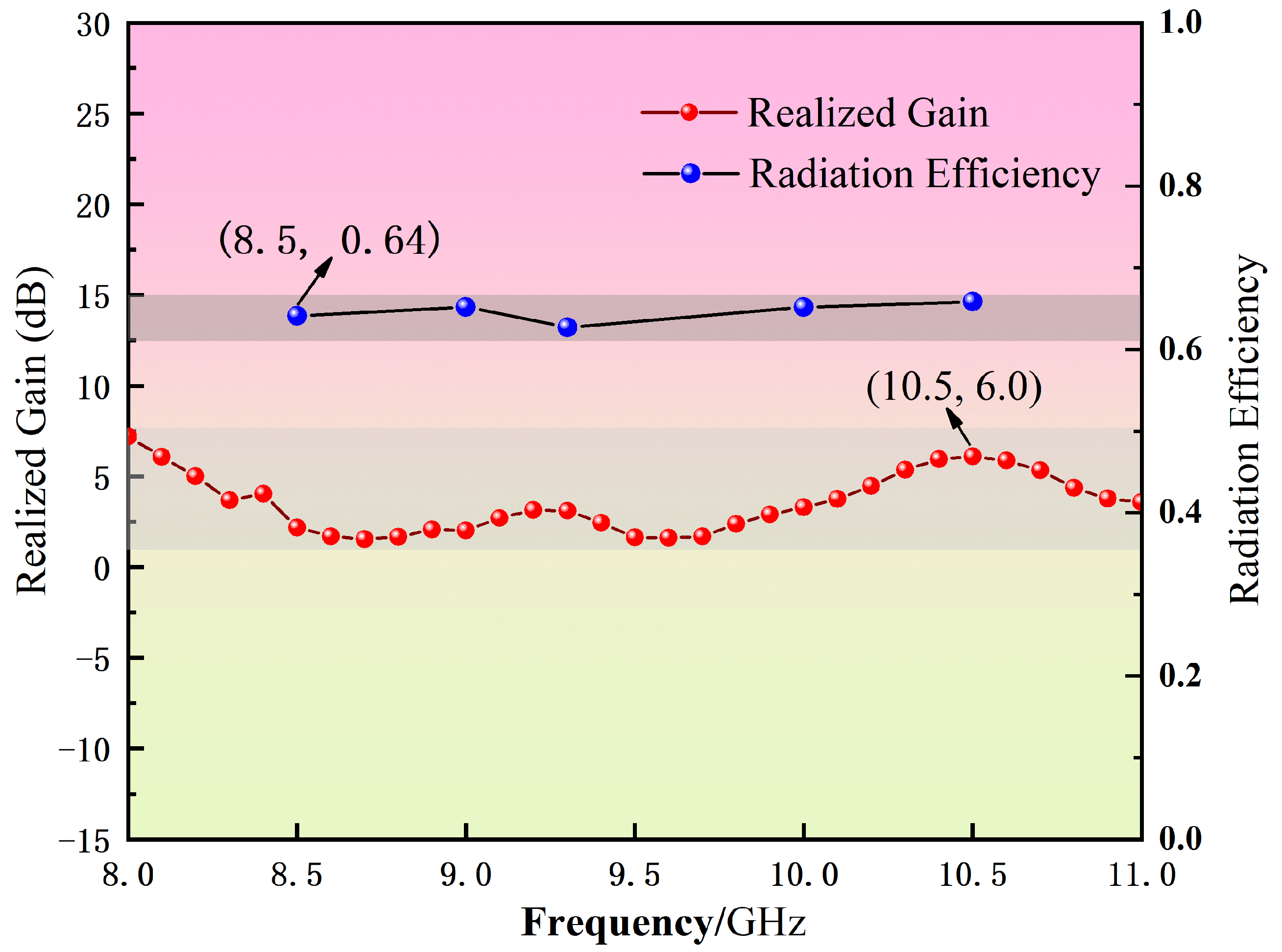
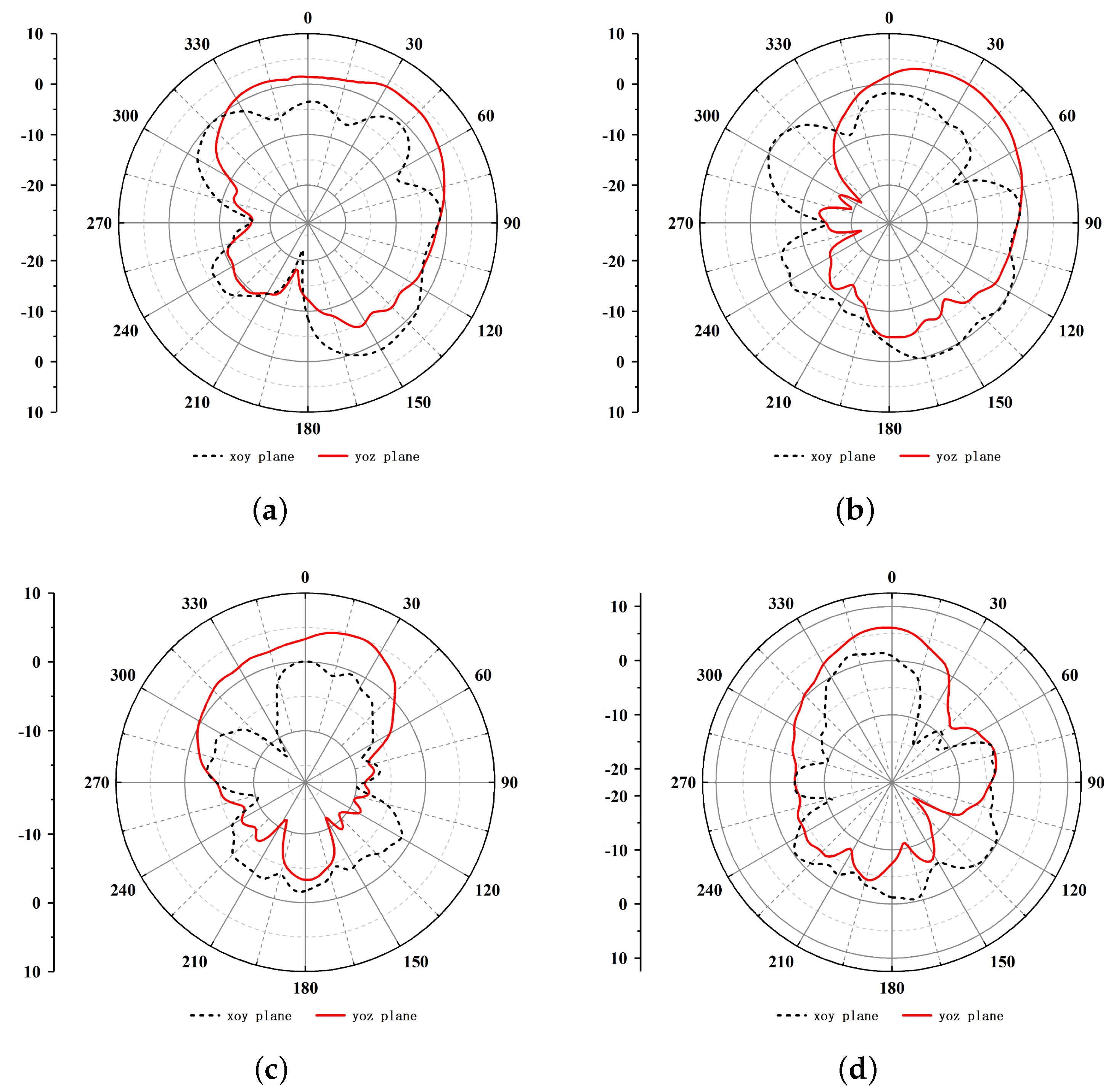
| Symbol | Meaning |
|---|---|
| Uniform distribution on | |
| A serie or list which contain n elements for to | |
| The set of all projections from to | |
| The set of HFSS model | |
| L | Side length of the substrate |
| h | Thickness of the substrate |
| The i-th vertex of polygon | |
| f | Distance from feed probe to the center of the substrate |
| Designed Antenna | Frequency Band (GHz) | Patch Type | Relative Bandwidth | Size of Antenna (mm3) | Return Loss (dB) |
|---|---|---|---|---|---|
| Reference [35] | 9.3–10.5 | Rectangular | 12.1% | −19.8 | |
| Reference [36] | 9.2–9.8 | Rectangular | 6.3% | −23.8 | |
| 8.7–9.2 | Triangular | 5.5% | −17.8 | ||
| 9.0–9.7 | Circular | 7.4% | −18.5 | ||
| Reference [37] | 10.3–11.7 | Circular | 12.7% | −17.1 | |
| Proposed antenna | 8.3–11.0 | IPPA | 27.9% | −30.0 |
Disclaimer/Publisher’s Note: The statements, opinions and data contained in all publications are solely those of the individual author(s) and contributor(s) and not of MDPI and/or the editor(s). MDPI and/or the editor(s) disclaim responsibility for any injury to people or property resulting from any ideas, methods, instructions or products referred to in the content. |
© 2025 by the authors. Licensee MDPI, Basel, Switzerland. This article is an open access article distributed under the terms and conditions of the Creative Commons Attribution (CC BY) license (https://creativecommons.org/licenses/by/4.0/).
Share and Cite
Ma, Z.; Liu, J. An Improved NSGA-II Algorithm for Multi-Objective Optimization of Irregular Polygon Patch Antennas. Micromachines 2025, 16, 786. https://doi.org/10.3390/mi16070786
Ma Z, Liu J. An Improved NSGA-II Algorithm for Multi-Objective Optimization of Irregular Polygon Patch Antennas. Micromachines. 2025; 16(7):786. https://doi.org/10.3390/mi16070786
Chicago/Turabian StyleMa, Zhenyang, and Jiahao Liu. 2025. "An Improved NSGA-II Algorithm for Multi-Objective Optimization of Irregular Polygon Patch Antennas" Micromachines 16, no. 7: 786. https://doi.org/10.3390/mi16070786
APA StyleMa, Z., & Liu, J. (2025). An Improved NSGA-II Algorithm for Multi-Objective Optimization of Irregular Polygon Patch Antennas. Micromachines, 16(7), 786. https://doi.org/10.3390/mi16070786




